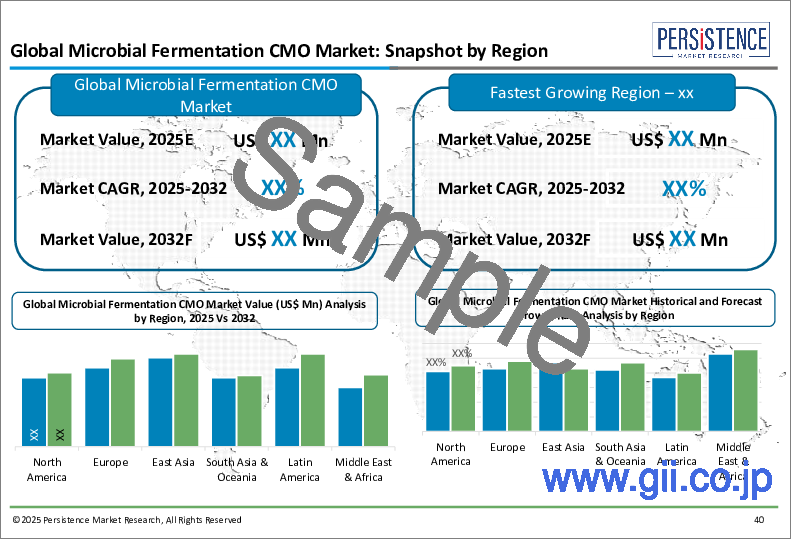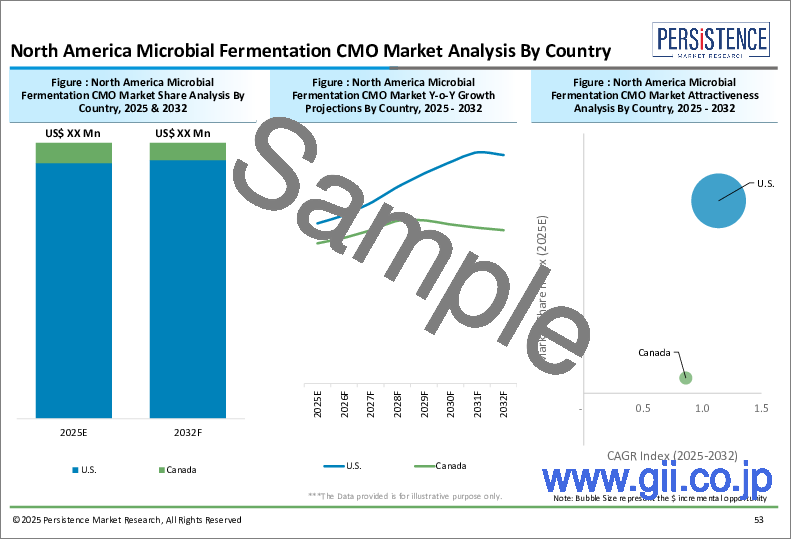|
|
市場調査レポート
商品コード
1572931
微生物発酵CMO市場:世界の産業分析、規模、シェア、成長、動向、予測、2024年~2031年Microbial Fermentation CMO Market: Global Industry Analysis, Size, Share, Growth, Trends, and Forecast, 2024-2031 |
||||||
カスタマイズ可能
|
|||||||
| 微生物発酵CMO市場:世界の産業分析、規模、シェア、成長、動向、予測、2024年~2031年 |
|
出版日: 2024年10月11日
発行: Persistence Market Research
ページ情報: 英文 210 Pages
納期: 2~5営業日
|
- 全表示
- 概要
- 目次
Persistence Market Researchはこのほど、世界の微生物発酵受託製造機関(CMO)市場を詳細に調査した包括的なレポートを発行しました。当レポートでは、市場促進要因・動向・機会・課題などの主要な市場力学を徹底的に評価し、市場構造に関する詳細な洞察を提供しています。この調査レポートは、2024年から2031年までの世界の微生物発酵CMO市場の予測成長軌道を概説する独占データと統計を掲載しています。
主要な洞察
- 微生物発酵CMOの市場規模(2024年):38億米ドル
- 予測市場金額(2031年):69億米ドル
- 予測成長率(CAGR 2024年~2031年):8.9%
微生物発酵CMO市場 - 調査範囲:
微生物発酵CMO市場は、医薬品、食品・飲料、農業、工業製造など様々な分野で重要な役割を果たしています。この市場は、細菌、酵母、真菌などの微生物を活用して価値ある製品を生産しています。抗生物質、ワクチン、酵素の必要性からバイオ医薬品の需要が急増するにつれ、製薬会社は生産とスケールアップをCMOに依存するようになっています。
市場成長の促進要因:
世界の微生物発酵CMO市場は、慢性疾患の増加や高度な治療ソリューションに対する緊急のニーズなど、いくつかの重要な要因によって推進されています。糖尿病、がん、自己免疫疾患などの疾患によってバイオ医薬品の需要が増加し続ける中、高度な治療ソリューションの必要性が高まっています。この変化は、CMOが得意とする柔軟でスケーラブルな発酵プロセスの重要性を強調しています。
市場抑制要因:
前向きな成長展望にもかかわらず、微生物発酵CMO市場はサプライチェーンの複雑さに関連する課題に直面しています。高品質の原材料の調達における課題や、デリケートな生物学的材料の輸送における物流の課題が、市場の効率性を著しく阻害しています。発酵プロセスに不可欠な基質の入手可能性や品質が一定でないことは、生産の遅延やコスト増につながり、CMOが需要の増加に対応する能力に影響を与えます。
市場機会:
微生物発酵CMO市場は、持続可能性とグリーンテクノロジーによって大きな成長機会をもたらします。企業は、廃棄物やエネルギー消費を最小限に抑えるための発酵プロセスの最適化など、環境への影響を軽減するために持続可能な手法を採用するようになってきています。これは世界の持続可能性運動と一致しており、環境に優しい実践を優先するCMOに巨大な市場機会をもたらしています。
本レポートで扱う主要な質問
- 微生物発酵CMO市場の世界的成長を促す主要な要因は何か?
- バイオテクノロジーの進歩は微生物発酵CMO市場の競合情勢をどのように変えているか?
- バイオ医薬品分野のCMOの業務に影響を与えている規制上の課題は何か?
- 微生物発酵CMO市場の主要企業はどこで、関連性を維持するためにどのような戦略をとっているのか?
- 世界の微生物発酵CMO市場で予想される新たな動向と将来性は?
目次
第1章 エグゼクティブサマリー
第2章 市場概要
- 市場の範囲と定義
- 市場力学
- 促進要因
- 抑制要因
- 機会
- 課題
- 主要な動向
- マクロ経済要因
- 世界のセクター別展望
- 世界のGDP成長展望
- 世界のヘルスケア費支出展望
- COVID-19の影響分析
- 予測要因 - 関連性と影響
第3章 付加価値の洞察
- 規制状況
- バリューチェーン分析
- 主要な取引と合併
- PESTLE分析
- ポーターのファイブフォース分析
第4章 世界の微生物発酵CMO市場の展望:実績(2019年~2023年)と予測(2024年~2031年)
- 主要なハイライト
- 市場規模(百万米ドル)と前年比成長率
- 絶対額の機会
- 市場規模(百万米ドル)分析と予測
- 過去の市場規模(百万米ドル)分析、2019年~2023年
- 現在の市場規模(百万米ドル)分析と予測、2024年~2031年
- 世界の微生物発酵CMO市場の展望:発現システムのタイプ
- イントロダクション / 主要な調査結果
- 過去の市場規模(百万米ドル)分析、発現システムのタイプ別、2019年~2023年
- 現在の市場規模(百万米ドル)分析と予測、発現システムのタイプ別、2024年~2031年
- 細菌発現システム
- 酵母発現システム
- その他
- 市場の魅力分析:発現システムのタイプ
- 世界の微生物発酵CMO市場の展望:生物製剤のタイプ
- イントロダクション / 主要な調査結果
- 過去の市場規模(百万米ドル)分析、生物製剤のタイプ別、2019年~2023年
- 現在の市場規模(百万米ドル)分析と予測、生物製剤のタイプ別、2024年~2031年
- 酵素
- 抗体
- プラスミドDNA
- 組み換えタンパク質
- その他
- 市場の魅力分析:生物製剤のタイプ
- 世界の微生物発酵CMO市場の展望:エンドユーザー
- イントロダクション / 主要な調査結果
- 過去の市場規模(百万米ドル)分析、エンドユーザー別、2019年~2023年
- 現在の市場規模(百万米ドル)分析と予測、エンドユーザー別、2024年~2031年
- バイオ医薬品企業
- 学術・研究機関
- その他
- 市場の魅力分析:エンドユーザー
第5章 世界の微生物発酵CMO市場の展望:地域
- 主要なハイライト
- 過去の市場規模(百万米ドル)分析、地域別、2019年~2023年
- 現在の市場規模(百万米ドル)分析と予測、地域別、2024年~2031年
- 北米
- 欧州
- 東アジア
- 南アジア・オセアニア
- ラテンアメリカ
- 中東・アフリカ
- 市場の魅力分析:地域
第6章 北米の微生物発酵CMO市場の展望:実績(2019年~2023年)と予測(2024年~2031年)
第7章 欧州の微生物発酵CMO市場の展望:実績(2019年~2023年)と予測(2024年~2031年)
第8章 東アジアの微生物発酵CMO市場の展望:実績(2019年~2023年)と予測(2024年~2031年)
第9章 南アジア・オセアニアの微生物発酵CMO市場の展望:実績(2019年~2023年)と予測(2024年~2031年)
第10章 ラテンアメリカの微生物発酵CMO市場の展望:実績(2019年~2023年)と予測(2024年~2031年)
第11章 中東・アフリカの微生物発酵CMO市場の展望:実績(2019年~2023年)と予測(2024年~2031年)
第12章 競合情勢
- 市場構造
- 競合激化マップ:市場別
- 競合ダッシュボード
- 企業プロファイル(詳細 - 概要、財務、戦略、最近の動向)
- AbbVie Inc.
- BOC Sciences
- Eurofins Scientific
- FUJIFILM Diosynth Biotechnologies
- GSK plc
- Lonza Group AG
- Sandoz Group AG
- WuXi Biologics
- Evonik Industries
- DSM
- Sekisui Diagnostics
- AGC Biologics
- BIOVECTRA
- Avid Bioservices
第13章 付録
- 調査手法
- 調査の前提条件
- 頭字語と略語
Persistence Market Research has recently published a comprehensive report detailing the global microbial fermentation contract manufacturing organization (CMO) market. The report offers a thorough assessment of key market dynamics, including drivers, trends, opportunities, and challenges, providing detailed insights into the market structure. This research publication presents exclusive data and statistics outlining the anticipated growth trajectory of the global microbial fermentation CMO market from 2024 to 2031.
Key Insights:
- Microbial Fermentation CMO Market Size (2024E): US$3.8 Bn
- Projected Market Value (2031F): US$6.9 Bn
- Forecast Growth Rate (CAGR 2024-2031): 8.9%
Microbial Fermentation CMO Market - Report Scope:
The microbial fermentation CMO market plays a critical role across various sectors, including pharmaceuticals, food and beverages, agriculture, and industrial manufacturing. This market leverages microorganisms like bacteria, yeast, and fungi to produce valuable products. As demand for biopharmaceuticals surges, driven by the need for antibiotics, vaccines, and enzymes, pharmaceutical companies increasingly rely on CMOs for production and scale-up.
Market Growth Drivers:
The global microbial fermentation CMO market is propelled by several key factors, including the increasing prevalence of chronic diseases and the urgent need for advanced therapeutic solutions. As the demand for biopharmaceuticals continues to rise, driven by conditions such as diabetes, cancer, and autoimmune disorders, the necessity for advanced therapeutic solutions intensifies. This shift emphasizes the importance of flexible and scalable fermentation processes that CMOs specialize in.
Market Restraints:
Despite the positive growth outlook, the microbial fermentation CMO market faces challenges related to supply chain complexities. Issues in sourcing high-quality raw materials and logistical challenges in transporting sensitive biological materials significantly hinder market efficiency. Inconsistent availability and quality of essential substrates for fermentation processes can lead to production delays and increased costs, impacting the ability of CMOs to meet rising demand.
Market Opportunities:
The microbial fermentation CMO market presents significant growth opportunities driven by sustainability and green technologies. Companies are increasingly adopting sustainable practices to reduce their environmental impact, including optimizing fermentation processes to minimize waste and energy consumption. This aligns with the global sustainability movement, presenting a massive market opportunity for CMOs that prioritize environmentally friendly practices.
Key Questions Answered in the Report:
- What are the primary factors driving the growth of the microbial fermentation CMO market globally?
- How are advancements in biotechnology reshaping the competitive landscape of the microbial fermentation CMO market?
- What regulatory challenges are impacting the operations of CMOs in the biopharmaceutical sector?
- Which companies are the key players in the microbial fermentation CMO market, and what strategies are they employing to maintain relevance?
- What emerging trends and future prospects are anticipated in the global microbial fermentation CMO market?
Competitive Intelligence and Business Strategy:
Leading players in the global microbial fermentation CMO market, including Lonza, Samsung Biologics, and WuXi Biologics, focus on innovation, product differentiation, and strategic partnerships to gain a competitive edge. These companies are investing heavily in R&D to develop advanced fermentation technologies and scalable manufacturing solutions catering to diverse therapeutic needs. Collaborations with regulatory agencies, research institutions, and healthcare providers facilitate market access and promote technology adoption.
Key Companies Profiled:
- AbbVie Inc.
- BOC Sciences
- Eurofins Scientific
- FUJIFILM Diosynth Biotechnologies
- GSK plc
- Lonza Group AG
- Sandoz Group AG
- WuXi Biologics
- Evonik Industries
- DSM
- Sekisui Diagnostics
- AGC Biologics
- BIOVECTRA
- Avid Bioservices
Microbial Fermentation CMO Market Segmentation
By Expression System
- Bacterial Expression Systems
- Yeast Expression Systems
- Others
By Biologics
- Enzymes
- Antibodies
- Plasmid DNA
- Recombinant Proteins
- Others
By End User
- Biopharma Companies
- Academic & Research Institutes
- Others
By Region
- North America
- Europe
- Asia Pacific
- The Middle East and Africa
- Latin America
Table of Contents
1. Executive Summary
- 1.1. Global Microbial Fermentation CMO Market Snapshot, 2024-2031
- 1.2. Market Opportunity Assessment, 2024-2031, US$ Mn
- 1.3. Key Market Trends
- 1.4. Future Market Projections
- 1.5. Premium Market Insights
- 1.6. Industry Developments and Key Market Events
- 1.7. PMR Analysis and Recommendations
2. Market Overview
- 2.1. Market Scope and Definition
- 2.2. Market Dynamics
- 2.2.1. Drivers
- 2.2.2. Restraints
- 2.2.3. Opportunity
- 2.2.4. Challenges
- 2.2.5. Key Trends
- 2.3. Macro-Economic Factors
- 2.3.1. Global Sectorial Outlook
- 2.3.2. Global GDP Growth Outlook
- 2.3.3. Global Healthcare Spending Outlook
- 2.4. COVID-19 Impact Analysis
- 2.5. Forecast Factors - Relevance and Impact
3. Value Added Insights
- 3.1. Regulatory Landscape
- 3.2. Value Chain Analysis
- 3.3. Key Deals and Mergers
- 3.4. PESTLE Analysis
- 3.5. Porter's Five Force Analysis
4. Global Microbial Fermentation CMO Market Outlook: Historical (2019-2023) and Forecast (2024-2031)
- 4.1. Key Highlights
- 4.1.1. Market Size (US$ Mn) and Y-o-Y Growth
- 4.1.2. Absolute $ Opportunity
- 4.2. Market Size (US$ Mn) Analysis and Forecast
- 4.2.1. Historical Market Size (US$ Mn) Analysis, 2019-2023
- 4.2.2. Current Market Size (US$ Mn) Analysis and Forecast, 2024-2031
- 4.3. Global Microbial Fermentation CMO Market Outlook: Type of Expression Systems
- 4.3.1. Introduction / Key Findings
- 4.3.2. Historical Market Size (US$ Mn) Analysis, By Type of Expression Systems, 2019-2023
- 4.3.3. Current Market Size (US$ Mn) Analysis and Forecast, By Type of Expression Systems, 2024-2031
- 4.3.3.1. Bacterial Expression Systems
- 4.3.3.2. Yeast Expression Systems
- 4.3.3.3. Others
- 4.4. Market Attractiveness Analysis: Type of Expression Systems
- 4.5. Global Microbial Fermentation CMO Market Outlook: Type of Biologics
- 4.5.1. Introduction / Key Findings
- 4.5.2. Historical Market Size (US$ Mn) Analysis, By Type of Biologics, 2019-2023
- 4.5.3. Current Market Size (US$ Mn) Analysis and Forecast, By Type of Biologics, 2024-2031
- 4.5.3.1. Enzymes
- 4.5.3.2. Antibodies
- 4.5.3.3. Plasmid DNA
- 4.5.3.4. Recombinant Proteins
- 4.5.3.5. Others
- 4.6. Market Attractiveness Analysis: Type of Biologics
- 4.7. Global Microbial Fermentation CMO Market Outlook: End User
- 4.7.1. Introduction / Key Findings
- 4.7.2. Historical Market Size (US$ Mn) Analysis, By End User, 2019-2023
- 4.7.3. Current Market Size (US$ Mn) Analysis and Forecast, By End User, 2024-2031
- 4.7.3.1. Biopharma Companies
- 4.7.3.2. Academic & Research Institutes
- 4.7.3.3. Others
- 4.8. Market Attractiveness Analysis: End User
5. Global Microbial Fermentation CMO Market Outlook: Region
- 5.1. Key Highlights
- 5.2. Historical Market Size (US$ Mn) Analysis, By Region, 2019-2023
- 5.3. Current Market Size (US$ Mn) Analysis and Forecast, By Region, 2024-2031
- 5.3.1. North America
- 5.3.2. Europe
- 5.3.3. East Asia
- 5.3.4. South Asia and Oceania
- 5.3.5. Latin America
- 5.3.6. Middle East & Africa
- 5.4. Market Attractiveness Analysis: Region
6. North America Microbial Fermentation CMO Market Outlook: Historical (2019-2023) and Forecast (2024-2031)
- 6.1. Key Highlights
- 6.2. Historical Market Size (US$ Mn) Analysis, By Market, 2019-2023
- 6.2.1. By Country
- 6.2.2. By Type of Expression Systems
- 6.2.3. By Type of Biologics
- 6.2.4. By End User
- 6.3. Current Market Size (US$ Mn) Analysis and Forecast, By Country, 2024-2031
- 6.3.1. U.S.
- 6.3.2. Canada
- 6.4. Current Market Size (US$ Mn) Analysis and Forecast, By Type of Expression Systems, 2024-2031
- 6.4.1. Bacterial Expression Systems
- 6.4.2. Yeast Expression Systems
- 6.4.3. Others
- 6.5. Current Market Size (US$ Mn) Analysis and Forecast, By Type of Biologics, 2024-2031
- 6.5.1. Enzymes
- 6.5.2. Antibodies
- 6.5.3. Plasmid DNA
- 6.5.4. Recombinant Proteins
- 6.5.5. Others
- 6.6. Current Market Size (US$ Mn) Analysis and Forecast, By End User, 2024-2031
- 6.6.1. Biopharma Companies
- 6.6.2. Academic & Research Institutes
- 6.6.3. Others
- 6.7. Market Attractiveness Analysis
7. Europe Microbial Fermentation CMO Market Outlook: Historical (2019-2023) and Forecast (2024-2031)
- 7.1. Key Highlights
- 7.2. Historical Market Size (US$ Mn) Analysis, By Market, 2019-2023
- 7.2.1. By Country
- 7.2.2. By Type of Expression Systems
- 7.2.3. By Type of Biologics
- 7.2.4. By End User
- 7.3. Current Market Size (US$ Mn) Analysis and Forecast, By Country, 2024-2031
- 7.3.1. Germany
- 7.3.2. France
- 7.3.3. U.K.
- 7.3.4. Italy
- 7.3.5. Spain
- 7.3.6. Russia
- 7.3.7. Turkiye
- 7.3.8. Rest of Europe
- 7.4. Current Market Size (US$ Mn) Analysis and Forecast, By Type of Expression Systems, 2024-2031
- 7.4.1. Bacterial Expression Systems
- 7.4.2. Yeast Expression Systems
- 7.4.3. Others
- 7.5. Current Market Size (US$ Mn) Analysis and Forecast, By Type of Biologics, 2024-2031
- 7.5.1. Enzymes
- 7.5.2. Antibodies
- 7.5.3. Plasmid DNA
- 7.5.4. Recombinant Proteins
- 7.5.5. Others
- 7.6. Current Market Size (US$ Mn) Analysis and Forecast, By End User, 2024-2031
- 7.6.1. Biopharma Companies
- 7.6.2. Academic & Research Institutes
- 7.6.3. Others
- 7.7. Market Attractiveness Analysis
8. East Asia Microbial Fermentation CMO Market Outlook: Historical (2019-2023) and Forecast (2024-2031)
- 8.1. Key Highlights
- 8.2. Historical Market Size (US$ Mn) Analysis, By Market, 2019-2023
- 8.2.1. By Country
- 8.2.2. By Type of Expression Systems
- 8.2.3. By Type of Biologics
- 8.2.4. By End User
- 8.3. Current Market Size (US$ Mn) Analysis and Forecast, By Country, 2024-2031
- 8.3.1. China
- 8.3.2. Japan
- 8.3.3. South Korea
- 8.4. Current Market Size (US$ Mn) Analysis and Forecast, By Type of Expression Systems, 2024-2031
- 8.4.1. Bacterial Expression Systems
- 8.4.2. Yeast Expression Systems
- 8.4.3. Others
- 8.5. Current Market Size (US$ Mn) Analysis and Forecast, By Type of Biologics, 2024-2031
- 8.5.1. Enzymes
- 8.5.2. Antibodies
- 8.5.3. Plasmid DNA
- 8.5.4. Recombinant Proteins
- 8.5.5. Others
- 8.6. Current Market Size (US$ Mn) Analysis and Forecast, By End User, 2024-2031
- 8.6.1. Biopharma Companies
- 8.6.2. Academic & Research Institutes
- 8.6.3. Others
- 8.7. Market Attractiveness Analysis
9. South Asia & Oceania Microbial Fermentation CMO Market Outlook: Historical (2019-2023) and Forecast (2024-2031)
- 9.1. Key Highlights
- 9.2. Historical Market Size (US$ Mn) Analysis, By Market, 2019-2023
- 9.2.1. By Country
- 9.2.2. By Type of Expression Systems
- 9.2.3. By Type of Biologics
- 9.2.4. By End User
- 9.3. Current Market Size (US$ Mn) Analysis and Forecast, By Country, 2024-2031
- 9.3.1. India
- 9.3.2. Southeast Asia
- 9.3.3. ANZ
- 9.3.4. Rest of South Asia & Oceania
- 9.4. Current Market Size (US$ Mn) Analysis and Forecast, By Type of Expression Systems, 2024-2031
- 9.4.1. Bacterial Expression Systems
- 9.4.2. Yeast Expression Systems
- 9.4.3. Others
- 9.5. Current Market Size (US$ Mn) Analysis and Forecast, By Type of Biologics, 2024-2031
- 9.5.1. Enzymes
- 9.5.2. Antibodies
- 9.5.3. Plasmid DNA
- 9.5.4. Recombinant Proteins
- 9.5.5. Others
- 9.6. Current Market Size (US$ Mn) Analysis and Forecast, By End User, 2024-2031
- 9.6.1. Biopharma Companies
- 9.6.2. Academic & Research Institutes
- 9.6.3. Others
- 9.7. Market Attractiveness Analysis
10. Latin America Microbial Fermentation CMO Market Outlook: Historical (2019-2023) and Forecast (2024-2031)
- 10.1. Key Highlights
- 10.2. Historical Market Size (US$ Mn) Analysis, By Market, 2019-2023
- 10.2.1. By Country
- 10.2.2. By Type of Expression Systems
- 10.2.3. By Type of Biologics
- 10.2.4. By End User
- 10.3. Current Market Size (US$ Mn) Analysis and Forecast, By Country, 2024-2031
- 10.3.1. Brazil
- 10.3.2. Mexico
- 10.3.3. Rest of Latin America
- 10.4. Current Market Size (US$ Mn) Analysis and Forecast, By Type of Expression Systems, 2024-2031
- 10.4.1. Bacterial Expression Systems
- 10.4.2. Yeast Expression Systems
- 10.4.3. Others
- 10.5. Current Market Size (US$ Mn) Analysis and Forecast, By Type of Biologics, 2024-2031
- 10.5.1. Enzymes
- 10.5.2. Antibodies
- 10.5.3. Plasmid DNA
- 10.5.4. Recombinant Proteins
- 10.5.5. Others
- 10.6. Current Market Size (US$ Mn) Analysis and Forecast, By End User, 2024-2031
- 10.6.1. Biopharma Companies
- 10.6.2. Academic & Research Institutes
- 10.6.3. Others
- 10.7. Market Attractiveness Analysis
11. Middle East & Africa Microbial Fermentation CMO Market Outlook: Historical (2019-2023) and Forecast (2024-2031)
- 11.1. Key Highlights
- 11.2. Historical Market Size (US$ Mn) Analysis, By Market, 2019-2023
- 11.2.1. By Country
- 11.2.2. By Type of Expression Systems
- 11.2.3. By Type of Biologics
- 11.2.4. By End User
- 11.3. Current Market Size (US$ Mn) Analysis and Forecast, By Country, 2024-2031
- 11.3.1. GCC Countries
- 11.3.2. Egypt
- 11.3.3. South Africa
- 11.3.4. Northern Africa
- 11.3.5. Rest of Middle East & Africa
- 11.4. Current Market Size (US$ Mn) Analysis and Forecast, By Type of Expression Systems, 2024-2031
- 11.4.1. Bacterial Expression Systems
- 11.4.2. Yeast Expression Systems
- 11.4.3. Others
- 11.5. Current Market Size (US$ Mn) Analysis and Forecast, By Type of Biologics, 2024-2031
- 11.5.1. Enzymes
- 11.5.2. Antibodies
- 11.5.3. Plasmid DNA
- 11.5.4. Recombinant Proteins
- 11.5.5. Others
- 11.6. Current Market Size (US$ Mn) Analysis and Forecast, By End User, 2024-2031
- 11.6.1. Biopharma Companies
- 11.6.2. Academic & Research Institutes
- 11.6.3. Others
- 11.7. Market Attractiveness Analysis
12. Competition Landscape
- 12.1. Market Structure
- 12.1.1. Competition Intensity Mapping By Market
- 12.1.2. Competition Dashboard
- 12.2. Company Profiles (Details - Overview, Financials, Strategy, Recent Developments)
- 12.2.1. AbbVie Inc.
- 12.2.1.1. Overview
- 12.2.1.2. Segments and Products
- 12.2.1.3. Key Financials
- 12.2.1.4. Market Developments
- 12.2.1.5. Market Strategy
- 12.2.2. BOC Sciences
- 12.2.2.1. Overview
- 12.2.2.2. Segments and Products
- 12.2.2.3. Key Financials
- 12.2.2.4. Market Developments
- 12.2.2.5. Market Strategy
- 12.2.3. Eurofins Scientific
- 12.2.3.1. Overview
- 12.2.3.2. Segments and Products
- 12.2.3.3. Key Financials
- 12.2.3.4. Market Developments
- 12.2.3.5. Market Strategy
- 12.2.4. FUJIFILM Diosynth Biotechnologies
- 12.2.4.1. Overview
- 12.2.4.2. Segments and Products
- 12.2.4.3. Key Financials
- 12.2.4.4. Market Developments
- 12.2.4.5. Market Strategy
- 12.2.5. GSK plc
- 12.2.5.1. Overview
- 12.2.5.2. Segments and Products
- 12.2.5.3. Key Financials
- 12.2.5.4. Market Developments
- 12.2.5.5. Market Strategy
- 12.2.6. Lonza Group AG
- 12.2.6.1. Overview
- 12.2.6.2. Segments and Products
- 12.2.6.3. Key Financials
- 12.2.6.4. Market Developments
- 12.2.6.5. Market Strategy
- 12.2.7. Sandoz Group AG
- 12.2.7.1. Overview
- 12.2.7.2. Segments and Products
- 12.2.7.3. Key Financials
- 12.2.7.4. Market Developments
- 12.2.7.5. Market Strategy
- 12.2.8. WuXi Biologics
- 12.2.8.1. Overview
- 12.2.8.2. Segments and Products
- 12.2.8.3. Key Financials
- 12.2.8.4. Market Developments
- 12.2.8.5. Market Strategy
- 12.2.9. Evonik Industries
- 12.2.9.1. Overview
- 12.2.9.2. Segments and Products
- 12.2.9.3. Key Financials
- 12.2.9.4. Market Developments
- 12.2.9.5. Market Strategy
- 12.2.10. DSM
- 12.2.10.1. Overview
- 12.2.10.2. Segments and Products
- 12.2.10.3. Key Financials
- 12.2.10.4. Market Developments
- 12.2.10.5. Market Strategy
- 12.2.11. Sekisui Diagnostics
- 12.2.11.1. Overview
- 12.2.11.2. Segments and Products
- 12.2.11.3. Key Financials
- 12.2.11.4. Market Developments
- 12.2.11.5. Market Strategy
- 12.2.12. AGC Biologics
- 12.2.12.1. Overview
- 12.2.12.2. Segments and Products
- 12.2.12.3. Key Financials
- 12.2.12.4. Market Developments
- 12.2.12.5. Market Strategy
- 12.2.13. BIOVECTRA
- 12.2.13.1. Overview
- 12.2.13.2. Segments and Products
- 12.2.13.3. Key Financials
- 12.2.13.4. Market Developments
- 12.2.13.5. Market Strategy
- 12.2.14. Avid Bioservices
- 12.2.14.1. Overview
- 12.2.14.2. Segments and Products
- 12.2.14.3. Key Financials
- 12.2.14.4. Market Developments
- 12.2.14.5. Market Strategy
- 12.2.1. AbbVie Inc.
13. Appendix
- 13.1. Research Methodology
- 13.2. Research Assumptions
- 13.3. Acronyms and Abbreviations






